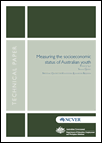Description
When measuring the socioeconomic status of young people, the authors find that the SocioEconomic Indexes for Areas (SEIFA) works well when reporting participation in higher education at aggregate levels, but performs very poorly when classifying individuals. This has policy implications because it means that programs directing resources to increase educational participation for those with low socioeconomic status may be doing so based on incorrect information. The data used come from the 2003 cohort of the Longitudinal Surveys of Australian Youth (LSAY), looking at young people aged 15 to 25 years.Summary
About the research
Developing an accurate measurement of individual socioeconomic status (SES) is important, particularly because of current policy interest in increasing educational participation among those from a low SES background. Typically, we do not have data on all the underlying characteristics that make up the concept of SES. Consequently, SES is usually measured indirectly, such as through the Socio-Economic Indexes for Areas (SEIFA) or through parental occupation or education. The issue is how satisfactory these proxies are in measuring 'true' SES.
Using the 2003 cohort of the Longitudinal Surveys of Australian Youth (LSAY), Lim and Gemici focus on measuring the SES of young people aged 15 to 25 years. The authors create a measure of individual SES that captures the impact of cultural and educational resources, as well as parental education and occupation.
The authors find:
- SEIFA greatly misclassifies SES at the individual level (almost 40% of individuals are wrongly classified as high or low SES).
- SEIFA composites result in only a marginal improvement in classification accuracy.
- SEIFA and SEIFA composites perform reasonably well when reporting participation in higher education at aggregate levels.
- SEIFA and SEIFA composites perform reasonably well in multivariate modelling, although the relationship between participation and socioeconomic disadvantage is underestimated using SEIFA measures.
The implications are that SEIFA is satisfactory when determining aggregate relationships, but performs very poorly when classifying individuals. This is problematic for programs which direct resources to individuals: use of an area-based measure of SES will result in the misallocation of resources.
Tom Karmel
Managing Director, NCVER
